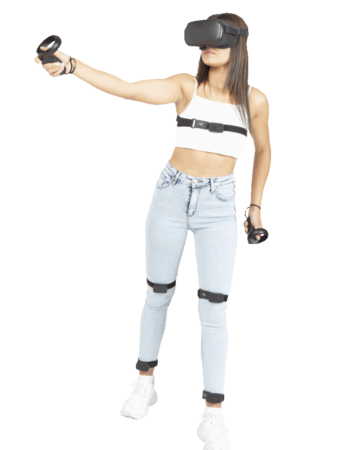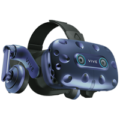Over my time in VR I have tried locomotion options like 3dRudder and Cybershoes, so I am always interested when companies try to bring locomotion methods to VR. So, getting the chance to try WalkOVR really interested me and the added bonus of they can also be used as Mocap for bodytracking these could be a steal at the cost of $249. I have now been running them through some vigorous testing – how did they perform?
What’s in the box?
Inside of the box you get the five motion nodes, straps and changing cables. You also get the instructions for downloading the OVR Portal software and a digital instruction manual. One thing I was surprised to see not included in the box was a Bluetooth 5.0 dongle – as WalkOVR needs 5.0 to work at optimal performance.
Setting up the product
When first looking into the product I thought that they might be a pain to setup and get synced, but how easy they were to setup and get working was a massive shock. Firstly you need to install the OVR Portal, this is where all the wizardry takes place in getting them working with your game. Once this is installed, you place one of the nodes on your chest, each knee and each ankle with the provided straps.
Once these are in place, make sure your bluetooth dongle is connect and turned on in system settings on your PC, open Steam VR, then open OVR Portal and click Search and Connect. This will then find each node in no time at all, now run the few calibration steps in the portal and you are ready to boot-up the game and play using WalkOVR.
If you are wanting to Switch between locomotion and MOCAP mode, it will ask you to restart Steam VR and to run the Search and Connect again in the portal. Again like the setup this takes no time at all, and your ready to go in another mode.

Benefits
WalkOVR brings with it a number of benefits, but the main use of the product is bring a locomotion system, that not only feels more natural that analogue sticks – but helps reduce the effects of motion sickness that some VR users experience. Although, I personally do not suffer from motion sickness in VR, I can really see how the product could help those who do, with the product giving the feeling of walking with the movement in the game – tricking the brain in a way.
Using the locomotion method also comes with fitness benefits as while using them, you are also walking on the spot – rather than sitting or standing still while gaming. With this in mind, the OVR Portal also offers a tracker for the fitness element, showing you the details like minutes played and calories burnt while playing.
It also brings five-point body tracking for the cost of two HTC Vive trackers, meaning for those who don’t have the expendable cash for three-plus VIVE trackers but want to have body tracking – this makes it a viable option.
Testing the product
As previously mentioned, the nodes offer both Locomotion and Mocap, these are two separate modes and are selected with the OVR portal. I have been testing both modes out in a number of games and applications.
But, before I go into the modes, I would like to mention the weight of the nodes, or lack of weight in this case – with the nodes weighing 30-grams each. This makes them super comfortable to use, as they are so light.
Locomotion (Decoupling)
In locomotion mode, the nodes are used to convert you walking on the spot to movement in the game. There is large number of games that support this mode, the full list can be found on the WalkOVR website.
I wanted to try a good number of the supported games, to give this mode a good test. So, I went across as many genres of the games that I could that I already had in my library. The testing of this mode really surprised me, as someone who uses the avatar I was looking forward to the MOCAP mode and testing the tracking capabilities – but this mode is where I will see myself using WalkOVR most.
Every game that I tested was really simple to get it working, however I did find calibrating the trackers after switching games made them the most responsive in each one I played. This only takes thirty-seconds max. so this is not a time consuming action and is done really easily via the OVR Portal.
A few things I found in this mode, it’s a good idea to have either a pully system for your wire or use them with a wireless headset. The reason for this is I found a number of times I stood on the wire while walking on the spot, and ended up switching to my Vive Pro with the wireless adaptor when using this mode. Secondly I had to get out my proximity mat, as I am still finding I walk in my playspace rather than on the spot at times.

MOCAP
For MOCAP mode I went into Neos VR, the main application I use my VIVE bodytracking on, VRChat and Chillout VR, as I feel the bodytracking is mainly used within social VR.
Now, if you are looking a cheaper method of full bodytracking over things like VIVE trackers, these do the job of simulating the tracking offered by VIVE. However, they are not as accurate as using the base stations with them using Bluetooth for the tracking method, but the team is always looking to release updates to improve the MOCAP feature.
When it comes to the testing in the apps, VRChat picked them up pretty easily and I found them very simple to setup. I really didn’t get them working in Chillout VR, but, I am not sure if that is because I never created my avatar correctly or that the tracking setup is odd on the application its self. As I have read the foot-tracking uses the last bone on your foot – and that would be the toe bones on mine.
With Neos VR the body tracking is much more customisable, and this did take some tinkering inside of the application to get it working well for my avatar. But, to get the game to pick them up was simple enough, it was more just getting them correct for the Rexouium.
Battery Length
With these being a wireless system with the nodes connecting via Bluetooth, each node has it’s own battery, over my time testing them I found they take around two-hours to fully charge from no charge, and will last around two to three-hours of use. Which by that time, you are usually ready for a break of walking in locomotion mode, but this needs to be kept in mind if using MOCAP.
One more issue I found, is the trackers have no permanent indicator to show they are charging. There was one time in testing I put them on charge, so I can carry on with more later in the evening and the USB cable had come out the PC slightly after plugging it in. Due to the nodes not having a permanent charging indicator, when I came back one of them was not charged. I think it would be a lot more useful to have some sort of charge indicator.
Reviewed using HTC Vive Pro

For the purposes of transparency, this review was created using a review product provided by the company or their respective PR company. The use of a review product does not affect my judgement of the product.
Review Overview

WalkOVR MOCAP option brings with it two uses for the device, one that works excellently and one that needs a little work. The main use that really surprised me was the locomotion mode, and how easy it was to get working and using it within the games. The MOCAP mode works, but does need a little work on how well it is read with it using Bluetooth – but this is a mode the team are always looking into and improving with updates. Coming in at $249, it not only offers the great locomotion option but is more affordable five-point tracking. Now, there is a few things I was surprised to see not included and those are a Bluetooth dongle as it requires one and no charging indicator on the nodes, however, these are little things that do not effect the overall performance of the product. With the ease of the setup and attaching and removing the nodes, I can see the product getting a good bit of use in the large amount of supported games.





